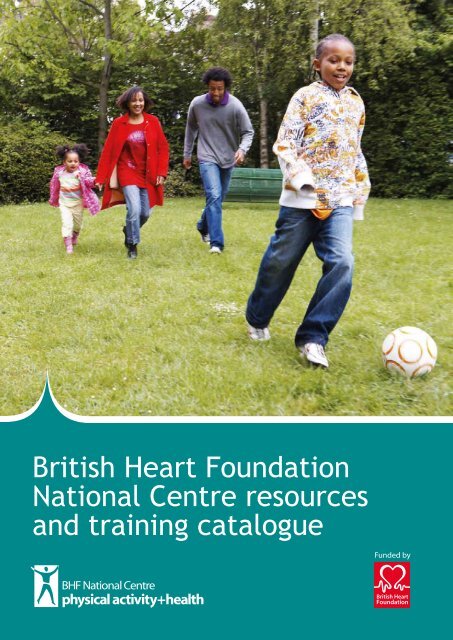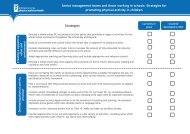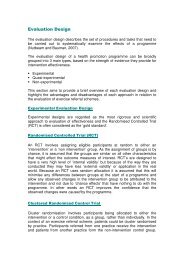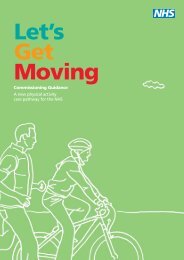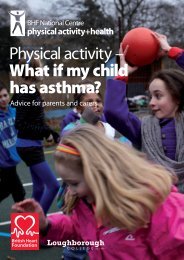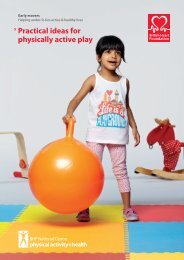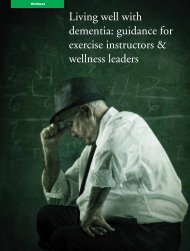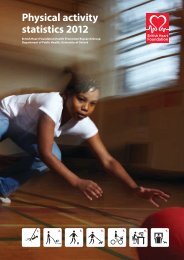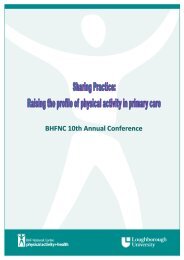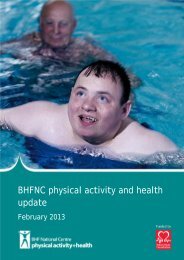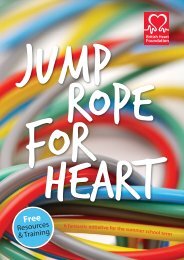Download the BFHNC resources and training catalogue
Download the BFHNC resources and training catalogue
Download the BFHNC resources and training catalogue
Create successful ePaper yourself
Turn your PDF publications into a flip-book with our unique Google optimized e-Paper software.
British Heart FoundationNational Centre <strong>resources</strong><strong>and</strong> <strong>training</strong> <strong>catalogue</strong>Funded by
ContentsThe BHF National Centre forPhysical Activity <strong>and</strong> Health(BHFNC) is funded by <strong>the</strong>British Heart Foundation. Weare also part of <strong>the</strong> prestigiousSchool of Sport, Exercise<strong>and</strong> Health Sciences atLoughborough University.The BHFNC is well recognisedacross <strong>the</strong> UK for its leadershipin <strong>the</strong> promotion of physicalactivity <strong>and</strong> health. We arecommitted to developing <strong>and</strong>translating research evidenceto improve <strong>and</strong> extend <strong>the</strong>practice of promoting physicalactivity in <strong>the</strong> UK.We do this by supportingprofessionals across a range ofsectors including health care,education, transport, sport <strong>and</strong>leisure with practical tools topromote physical activity.Children <strong>and</strong> young people 1UK Physical Activity Guidelines for Early YearsPhysical activity for <strong>the</strong> early yearsPhysical activity patterns – children <strong>and</strong> young peopleNational Physical Activity Audit of Children’s Centres<strong>and</strong> NurseriesTop tips to promote walking to schoolLet’s get active award pocket plannerGet kids on <strong>the</strong> go!Couch kids: <strong>the</strong> nation’s future…Active School packPrimary care 6What if my child has…?Exercise referral toolkitTop tips for engaging primary care professionalsOlder adults 8Active Ageing EventsActive for Later Life toolkitO<strong>the</strong>r <strong>resources</strong> 9BHFNC physical activity updateNational policy to local practiceHow to Engage Inactive Communities in Physical ActivityTraining 11Jump Rope workshopsFlames: Lighting <strong>the</strong> wayActive ClubActive AbilityPhysical activity for allPatient EmpowermentBHFNC annual conferenceWorld Congress on Active AgeingResearch <strong>and</strong> evaluation 16Well@Work EvaluationEvaluation of <strong>the</strong> Ramblers Family Walking ProgrammeEvaluation of <strong>the</strong> Eastern <strong>and</strong> Coastal Kent PCT ExerciseReferral ProgrammeInformation servicesKeep up-to-dateGot a burning question?British Heart Foundation <strong>resources</strong>back cover
Young peoplePhysical activity patterns– children <strong>and</strong> young peopleThese fact sheets pull toge<strong>the</strong>r <strong>the</strong> latest statistics onchildren <strong>and</strong> young people’s physical activity levels toprovide a picture of how active <strong>the</strong>y are. Statistics comefrom sources such as <strong>the</strong> Health Survey for Engl<strong>and</strong>,National Travel Survey <strong>and</strong> National H<strong>and</strong>s-Up Survey.These <strong>resources</strong> are designed for practitioners <strong>and</strong>professionals who want an overview of <strong>the</strong> facts. They canbe used to make <strong>the</strong> case for physical activity interventions.Fact SheetFact SheetThese fact sheets include information on:• general physical activity trends• travel to school• provision of PE <strong>and</strong> sport in schools• sedentary behaviour.There are currently three fact sheets available coveringphysical activity patterns in Engl<strong>and</strong>, Scotl<strong>and</strong> <strong>and</strong> Wales.<strong>Download</strong>: Physical activity patterns – children <strong>and</strong> young people in Engl<strong>and</strong><strong>Download</strong>: Physical activity patterns – children <strong>and</strong> young people in Scotl<strong>and</strong><strong>Download</strong>: Physical activity patterns – children <strong>and</strong> young people in WalesComing soon… information booklets for parents outlining <strong>the</strong> new physicalactivity guidelines <strong>and</strong> how <strong>the</strong>y can help <strong>the</strong>ir children meet <strong>the</strong>m will bepublished soon. Keep an eye on <strong>the</strong> BHFNC website www.bhfactive.org.ukfor more information.Costs Physical of activity patternsChildren <strong>and</strong> young people in Engl<strong>and</strong>Physical InactivityMaking physical activity a priorityFact SheetCosts Physical of activity patternsChildren <strong>and</strong> young people in Scotl<strong>and</strong>Physical InactivityMaking physical activity a priorityCosts Physical of activity patternsChildren <strong>and</strong> young people in WalesPhysical InactivityMaking physical activity a priorityNational Physical ActivityAudit of Children’s Centres<strong>and</strong> NurseriesThis BHFNC report outlines <strong>the</strong> findings of our NationalPhysical Activity Audit of Children’s Centres <strong>and</strong> Nurseries.With support from Toge<strong>the</strong>r for Children <strong>and</strong> <strong>the</strong> National DayNurseries Association <strong>the</strong> audit examined <strong>the</strong> physical activityprovision for <strong>the</strong> under fives in Children’s Centres<strong>and</strong> a sample of day care nurseries across <strong>the</strong> UK.The aims of <strong>the</strong> audit were to:• establish a picture of current provision• identify ways in which <strong>the</strong> BHFNC can support Children’sCentres to improve <strong>and</strong> exp<strong>and</strong> on <strong>the</strong>ir delivery ofphysical activity• highlight innovation <strong>and</strong> good practice.The findings of this audit are now helping to inform <strong>the</strong> BHFNC’s future work around early years.<strong>Download</strong>: National Physical Activity Audit of Children’s Centres <strong>and</strong> Nurseries2
Top tips to promote walking to schoolThis top tips leaflet looks at overcoming common barriers to walking toschool including:• concerns about road safety; traffic travelling too fast <strong>and</strong> difficultiescrossing roads• many parents drop off children on <strong>the</strong>ir way to work <strong>and</strong> feel <strong>the</strong>y don’thave time to walk• fear of ‘stranger danger’ stopping parents letting children walk toschool unaccompanied.Young peopleIt provides a range of tips to support teachers <strong>and</strong> o<strong>the</strong>r professionals inovercoming <strong>the</strong>se barriers <strong>and</strong> encourage active travel among staff, pupils <strong>and</strong><strong>the</strong>ir families.<strong>Download</strong>: Top tips to promote walking to schoolTo receive information about <strong>the</strong> latestBHFNC <strong>resources</strong> straight to your inboxsign up to our database atwww.bhfactive.org.uk/subscribe-to-database3
Young peopleThe BHFNC is funded by <strong>the</strong> British Heart Foundation. We also work very closely with <strong>the</strong> Charity to produce a number of joint<strong>resources</strong>. The <strong>resources</strong> outlined on <strong>the</strong> next two pages have been produced in conjunction with <strong>the</strong> British Heart Foundation.Let’s get active award pocket plannerThe Let’s get active award encourageschildren <strong>and</strong> young people to increase<strong>the</strong>ir levels of physical activity to meetor exceed <strong>the</strong> recommended 60 minutesof activity a day. To take part, childrenrecord <strong>the</strong>ir daily physical activity forsix consecutive weeks in <strong>the</strong> pocketplanner. This can include activitydone at a club, in school, walking orjust being active with friends. The 60minutes of physical activity does notall have to be done at once <strong>and</strong> canbe broken down into smaller chunks oftime, which makes it easier to fit in toeveryday life.After six weeks, children are awardeda free certificate of achievement inorder to recognise <strong>and</strong> reward regularparticipation in physical activity.Order: Let’s get active pocket plannerGet kids on <strong>the</strong> go!Get kids on <strong>the</strong> go is an information booklet for parents. It contains usefultips, hints <strong>and</strong> physical activity ideas to involve parents so <strong>the</strong>y underst<strong>and</strong><strong>the</strong> importance of physical activity <strong>and</strong> to help <strong>the</strong>m encourage <strong>and</strong> support<strong>the</strong>ir children to be active.Get kids on <strong>the</strong> go includes information on:• why being active is good for children• how much physical activity <strong>the</strong>y should be doing• ideas for activities <strong>the</strong>y may enjoy doing• what parents can do to help.<strong>Download</strong>: Get kids on <strong>the</strong> go!4
Couch kids: <strong>the</strong> nation’s future…This report draws on evidence from Engl<strong>and</strong>, Scotl<strong>and</strong>, Wales <strong>and</strong> Nor<strong>the</strong>rnIrel<strong>and</strong> to report <strong>the</strong> latest research on how much physical activity children<strong>and</strong> young people do <strong>and</strong> how much <strong>the</strong>y need to benefit <strong>the</strong>ir health. Thereport explores what can be done to encourage children <strong>and</strong> young people tobe more active.Young peopleCouch kids explores:• why physical activity is important for children <strong>and</strong> young people• how much physical activity children <strong>and</strong> young people should be doing• how active children <strong>and</strong> young people in <strong>the</strong> UK are• how sedentary children <strong>and</strong> young people are• factors associated with physical activity in children <strong>and</strong> young people.<strong>Download</strong>: Couch kids: <strong>the</strong> nation’s future…An eight-page executive summary of <strong>the</strong> Couch kids report is also available.The summary report highlights key findings from <strong>the</strong> full report <strong>and</strong> is auseful summary of <strong>the</strong> latest statistics on childhood obesity <strong>and</strong> physicalactivity levels.<strong>Download</strong>: Couch kids: <strong>the</strong> nation’s future… Executive summaryActive School packThe Active School pack helps to establish physical activity at <strong>the</strong> heart ofschools through providing case study examples <strong>and</strong> practical tips with clear,easily achievable steps.The resource includes nine st<strong>and</strong>-alone sections taking <strong>the</strong> user through <strong>the</strong>school day.These are:• essential guide for policy <strong>and</strong> planning• active travel to <strong>and</strong> from school• PE <strong>and</strong> physical activity across <strong>the</strong> curriculum• active break times <strong>and</strong> lunchtimes• out of school hours activities• promoting activity beyond <strong>the</strong> school day• involving partners/carers• sport days <strong>and</strong> o<strong>the</strong>r activity events• engaging all pupils.The pack contains 100 activity cards with simple practical ideas to improvephysical activity levels across <strong>the</strong> school day. Also included are information<strong>resources</strong>, <strong>training</strong> initiatives <strong>and</strong> contacts that can help schools develop<strong>the</strong>ir physical activity provision. A colourful A1 poster also helps with somesimple activities to do as part of a ten minute activity break in <strong>the</strong> classroom.Order: Active School pack5
Primary carePrimary carePhysical activity for allWhat if my child has…?These booklets are designed for parents or carers of children<strong>and</strong> young people who have long-term medical conditions. Theyexplain <strong>the</strong> benefits of physical activity for children <strong>and</strong> youngpeople <strong>and</strong> provide information to enable parents <strong>and</strong> carers toencourage <strong>the</strong>ir child to exercise safely. The booklets aim to makesure children are not discouraged from being active <strong>and</strong> help toovercome any anxieties both children <strong>and</strong> <strong>the</strong>ir parents or carersmay have about physical activity.These booklets do not replace <strong>the</strong> advice that a healthprofessional may give based on <strong>the</strong>ir knowledge of anindividual child’s condition.The booklets cover four medical conditions:• asthma• diabetes• obesity• congenital heart disease.The parental advice booklets are part of a suite of <strong>resources</strong> for<strong>the</strong> Physical activity for all <strong>training</strong> course. They are a supportivetool for professionals, such as PE teachers, exercise instructors<strong>and</strong> early years practitioners, to h<strong>and</strong> out to parents/carerswho express concerns about <strong>the</strong>ir child engaging in school PElessons or o<strong>the</strong>r physical activity sessions.<strong>Download</strong>: What if my child has asthma?<strong>Download</strong>: What if my child has diabetes?<strong>Download</strong>: What if my child is overweight?<strong>Download</strong>: What if my child has a congenitalheart condition?The Physical activity for all <strong>training</strong> course is designedfor practitioners <strong>and</strong> professionals who are directlyresponsible for delivering PE lessons or physical activitysessions with children <strong>and</strong> young people. For moreinformation see page 15.If you would like to order printed copies of <strong>the</strong>se bookletsplease contact Sarah Wortley on 01509 226419 or emails.a.wortley@lboro.ac.ukThey are available at a charge of £90 for 200 copies(plus postage <strong>and</strong> packaging).6
Exercise referral toolkitOne of <strong>the</strong> most popular approaches to promoting physical activity in <strong>the</strong>primary care setting has been through exercise referral schemes. Theseschemes are widespread in <strong>the</strong> UK <strong>and</strong> form an important part of <strong>the</strong>interface between healthcare practitioners, health promotion specialists<strong>and</strong> exercise professionals.Primary careThe BHFNC has taken a bottom up approach to <strong>the</strong> development of this toolkit.Its content <strong>and</strong> format have been shaped by a range of professionals who arecurrently responsible for, or who have experience of, delivering, co-ordinating,commissioning <strong>and</strong> evaluating exercise referral schemes. This exerciseprovided a snapshot of <strong>the</strong> nature <strong>and</strong> extent of exercise referral schemesin Engl<strong>and</strong>, Nor<strong>the</strong>rn Irel<strong>and</strong> <strong>and</strong> Scotl<strong>and</strong> <strong>and</strong> allowed us to gain a morecomprehensive underst<strong>and</strong>ing of how schemes are delivered <strong>and</strong> evaluated.The toolkit aims to provide an easy-to-read, practical guide for all thoseprofessionals involved in exercise referral schemes.The toolkit is divided into several easy-to-use sections:<strong>Download</strong>: Section 1: Background technical report<strong>Download</strong>: Section 2: A snapshot of exercise referral schemesoperating in Engl<strong>and</strong>, Scotl<strong>and</strong> <strong>and</strong> Nor<strong>the</strong>rnIrel<strong>and</strong><strong>Download</strong>: Section 3: A synopsis of exercise referral research<strong>Download</strong>: Section 4: A quick reference guide to exercisereferral schemes for referring healthcareprofessionals<strong>Download</strong>: Section 5: Guidance for exercise professionalsworking with referred patients<strong>Download</strong>: Section 6: Guidance for exercise referral schemecoordinators<strong>Download</strong>: Section 7: A guide to commissioning exercisereferral schemes<strong>Download</strong>: Section 8: A guide to evaluating exercise referralschemes<strong>Download</strong>: Section 9: A qualifications <strong>and</strong> <strong>training</strong> guide<strong>Download</strong>: Complete exercise referral toolkitFor fur<strong>the</strong>r information on <strong>the</strong> exercise referral toolkit go towww.bhfnc-exercisereferral.org.ukTop tips for engaging primarycare professionalsThe BHFNC 10th Annual Conference, ‘The cure for all ills is not to sit still: Raising<strong>the</strong> profile of physical activity within primary care’, explored how to embed physicalactivity into primary care agendas. This leaflet pulls toge<strong>the</strong>r <strong>the</strong> tips that emergedfrom <strong>the</strong> Conference for engaging primary care professionals in <strong>the</strong> promotion ofphysical activity.<strong>Download</strong>: Top tips for engaging primary care professionals in <strong>the</strong> promotion ofphysical activity7
Older adultsOlder adultsActive Ageing EventsThe BHFNC is leading a programme of Active Ageing Events with <strong>the</strong> purpose of:• providing a national <strong>and</strong> local profile to celebrate <strong>and</strong> promote <strong>the</strong>concept of active ageing• providing support for local Active Ageing Events <strong>and</strong> programmes• stimulating debate <strong>and</strong> policy on active ageing• ensuring older people are included in events designed to leave a health<strong>and</strong> physical activity legacy for high profile sporting events.The aim of <strong>the</strong>se <strong>resources</strong> is to provide practical guidance <strong>and</strong> ideas onimplementing Active Ageing Events. The <strong>resources</strong> have been developedin consultation with a range of professionals involved in <strong>the</strong> promotion ofactive ageing.• Co-ordinator’s planning guide – provides step by stepsuggestions on how to promote Active Ageing Events,<strong>and</strong> o<strong>the</strong>r activities that promote physical activity amongstolder people.• Ideas for action – full of ideas <strong>and</strong> promotional <strong>the</strong>mesdesigned to inspire Active Ageing Events <strong>and</strong> activities.• Promotion guide – includes helpful hints on physical activitypromotion, promotional materials <strong>and</strong> ideas on how to workwith <strong>the</strong> media to secure coverage of activities <strong>and</strong> spread<strong>the</strong> active ageing message.• Community organisation’s guide – for use by localcommunity organisations <strong>and</strong> groups to help <strong>the</strong>m organiseActive Ageing Events <strong>and</strong> spread <strong>the</strong> active ageing message.<strong>Download</strong>: Active Ageing Events Co-ordinator’s planning guide<strong>Download</strong>: Active Ageing ideas for action<strong>Download</strong>: Active Ageing promotion guide<strong>Download</strong>: Active Ageing community organisations’ guideFor fur<strong>the</strong>r information on <strong>the</strong> Active Ageing Eventsprogramme visit www.active-ageing-events.org.ukThe Active Ageing Events programme is supported by <strong>the</strong>Department of Work <strong>and</strong> Pensions Full of Life.Active for Later Life toolkitThe Active for Later Life toolkit is designed to help those involved in developing physicalactivity programmes for older people of all ages <strong>and</strong> abilities. It includes summaries ofevidence <strong>and</strong> recommendations, policy <strong>and</strong> strategic connections, <strong>and</strong> a series of workingpapers <strong>and</strong> practical guidance documents.The Active for Later Life resource can be used as an advocacy tool for managers <strong>and</strong>commissioners of health <strong>and</strong> o<strong>the</strong>r services as well as those involved in <strong>the</strong> strategicdevelopment of programmes for older people. It is also useful as a guide to planning to helpincrease opportunities for physical activity for older people.Active for Later Life is made up of six sections:<strong>Download</strong>: Active for Later Life Toolkit – Making <strong>the</strong> Case for Physical Activity<strong>Download</strong>: Active for Later Life Toolkit – Factors Affecting Planning<strong>Download</strong>: Active for Later Life Toolkit – A Guide to Programme Planning<strong>Download</strong>: Active for Later Life Toolkit – Working Papers<strong>Download</strong>: Active for Later Life Toolkit – Information Directory<strong>Download</strong>: Active for Later Life Toolkit – Putting it into Practice8
O<strong>the</strong>r <strong>resources</strong>BHFNC physical activity updateThe BHFNC physical activity update provides a round-up of all <strong>the</strong>recent developments in <strong>the</strong> field of physical activity <strong>and</strong> health.O<strong>the</strong>r <strong>resources</strong>This bi-monthly publication includes <strong>the</strong> latest information on:• <strong>training</strong> opportunities• key physical activity <strong>resources</strong> <strong>and</strong> publications• relevant conferences <strong>and</strong> events• recent research articles• physical activity in <strong>the</strong> news.…as well as all <strong>the</strong> latest news <strong>and</strong> publications from <strong>the</strong> BHFNC<strong>and</strong> <strong>the</strong> British Heart Foundation.To receive emails reminding you when <strong>the</strong> latest update isavailable sign up to our database atwww.bhfactive.org.uk/subscribe-to-databaseTo download <strong>the</strong> most recent physical activity <strong>and</strong> health update goto www.bhfactive.org.uk/homepage-<strong>resources</strong>-<strong>and</strong>-publicationsNational policy to local practice: Working toge<strong>the</strong>rto deliver physical activity programmesInformation sharing bookletThis information sharing booklet is a simple guide to <strong>the</strong>physical activity projects <strong>and</strong> interventions submitted tobe showcased at <strong>the</strong> 9th British Heart Foundation NationalCentre conference, National policy to local practice:Working toge<strong>the</strong>r to deliver physical activity programmes.This booklet focuses on projects across <strong>the</strong> UK workingto increase physical activity delivery through successfulpartnership working.This booklet is designed to:• encourage sharing of practice among health <strong>and</strong> physicalactivity professionals• increase awareness of <strong>the</strong> range of interventions takingplace across <strong>the</strong> UK• help identify gaps in physical activity provision.<strong>Download</strong>: National policy to local practice9
O<strong>the</strong>r <strong>resources</strong>How to engage inactivecommunities in physical activityTop tips from <strong>the</strong> BHFNC 8thannual conferenceThis booklet provides practical tips for engaging inactivecommunities in physical activity. The ideas presented here wereput forward by delegates <strong>and</strong> workshop facilitators during <strong>the</strong>BHFNC annual conference 2008.The booklet includes both generic tips, relevant to practitionersworking across a broad range of communities, as well as specifictips for engaging key target groups, for example people withdisabilities, girls <strong>and</strong> young women, older adults <strong>and</strong> peoplewith mental ill-health.This booklet includes:• an overview of <strong>the</strong> keynote presentations from <strong>the</strong> conference• a brief summary of each conference workshop• a summary of <strong>the</strong> tips <strong>and</strong> ideas generated during workshopdiscussions• <strong>resources</strong> <strong>and</strong> websites of relevance to professionalsseeking fur<strong>the</strong>r information on physical activity <strong>and</strong> specificpopulation groups.<strong>Download</strong>: How to engage inactive communities in physical activityDon’t forget our free helpline service,call 01509 226421or email bhfnc@lboro.ac.ukfor help with your physicalactivity related queries10
TrainingTrainingJump Rope workshopsWhat is Jump Rope?Jump Rope is basically skipping, but not as you know it! Jump Rope introduces new skipping techniques to suit all different abilities <strong>and</strong>new ideas to involve <strong>the</strong> whole class. Before you know it your class could be performing <strong>the</strong> twister, jumping jax or X-its!Jump Rope workshopsWe offer three different workshop options depending on what you are looking for:1. CPD for teachers <strong>and</strong> support staffA three-hour practical workshop which will get staffskipping, learning new skills <strong>and</strong> will help demonstratehow jump rope can work in <strong>the</strong> your setting. There is nopressure to perform <strong>and</strong> everyone has <strong>the</strong> opportunity topractise skills <strong>and</strong> ask questions.2. Pupil workshopsYes, we will teach <strong>the</strong> children too! These workshops canbe ei<strong>the</strong>r a full or half day <strong>and</strong> will be delivered by anexperienced instructor who will involve <strong>the</strong> whole class ina range of fun <strong>and</strong> effective activities.3. One hour CPD workshop for teachers <strong>and</strong> o<strong>the</strong>r staffThis is available as an optional extra when booking apupil workshop. It provides guidance on planning futurelessons, appropriate progressions <strong>and</strong> additional games<strong>and</strong> activities.For fur<strong>the</strong>r information please contact Margaret Couldwellon 01509 226418 or email m.couldwell@lboro.ac.uk or visit<strong>the</strong> BHFNC website www.bhfactive.org.uk/young-peopleto download a booking form.For our latest <strong>training</strong> dates visitwww.bhfactive.org.uk11
TrainingFlames: Lighting <strong>the</strong> wayFlames: Lighting <strong>the</strong> way is an Olympic <strong>and</strong> Paralympic Valuedriven programme, delivered by young leaders <strong>and</strong> centredaround physical activity <strong>and</strong> health.Flames was developed by <strong>the</strong> British Heart Foundation inpartnership with Loughborough College <strong>and</strong> delivered inassociation with <strong>the</strong> BHFNC. It began as a pilot projectin Loughborough <strong>and</strong> has since developed into a nationalprogramme, which schools, colleges <strong>and</strong> community groups canrun <strong>the</strong>mselves.Individuals who work with a group of young leaders orvolunteers are able to receive tutor <strong>training</strong> to equip <strong>the</strong>mwith <strong>the</strong> knowledge <strong>and</strong> <strong>resources</strong> to run <strong>the</strong>ir own Flamesprogramme. For example, <strong>the</strong> programme may be usefulto Sports Development Officers or staff from School SportsPartnerships, County Sports Partnerships or FE/HE colleges aswell as many o<strong>the</strong>rs.What to expect from free Flames Tutor TrainingWhat we provide:• initial support setting up <strong>the</strong> Flames programme in your area• British Heart Foundation Active Club resource packs• a range of relevant <strong>resources</strong> for participating primary schools/community groups• CD ROM with supporting <strong>resources</strong> to make <strong>the</strong> programme as easy as possible to implement• opportunity to use <strong>the</strong> 1948 Olympic torch for your Flames Festival• on-going support from <strong>the</strong> Flames project team• certificates for your young leaders <strong>and</strong> children taking part.What we require from you:• setting up <strong>and</strong> delivering a Flames programme in your area following <strong>the</strong> Flames model• completion of monitoring <strong>and</strong> evaluation including feedback from all groups involved• a brief summary of how you organised your Flames programme <strong>and</strong> a photo of your festival which we can upload to <strong>the</strong> website.For more information visit www.flameslighting<strong>the</strong>way.co.uk/<strong>training</strong>Active ClubThe Active Club programme is a practical introduction to outdoor games <strong>and</strong> healthrelated physical activity. It offers those working with children <strong>and</strong> young people<strong>training</strong> <strong>and</strong> practical ideas to develop skills, confidence <strong>and</strong> knowledge.Active Club <strong>training</strong> includes:• an introduction to some of <strong>the</strong> core principles of workingwith children <strong>and</strong> young people• tips on how to ensure all children <strong>and</strong> young people areengaged in activity• an opportunity to practise delivery skills as well as takepart in some of <strong>the</strong> activities• an introduction to <strong>the</strong> Active Club pack with a focus on<strong>the</strong> activity cards <strong>and</strong> advice on when <strong>the</strong> activities arebest used.As part of <strong>the</strong> <strong>training</strong> participants receive <strong>the</strong> Active Clubpack. This is a valuable resource providing simple, straightforward advice <strong>and</strong> practical ideas to help increase physicalactivity. The pack consists of:• illustrated activity cards providing over 100 practical activity ideas• templates <strong>and</strong> worksheets including certificates, crosswords <strong>and</strong> word searches• tips <strong>and</strong> ideas for developing physical activity provision in out-of-school settings• information summarising key <strong>resources</strong>, <strong>training</strong> opportunities, websites <strong>and</strong> contact details.For fur<strong>the</strong>r information visit www.activeclubs.org.uk12
Active AbilityActive Ability <strong>training</strong> enables physical activity <strong>and</strong> play leadersto include children <strong>and</strong> young people with a wide range ofabilities in physical activity.TrainingThe practical course also includes some specific informationon <strong>the</strong> inclusion of children <strong>and</strong> young people who havea particular cognitive, physical or sensory impairment.Participation in physical activity for <strong>the</strong>se young people isoften perceived as presenting a challenge to play <strong>and</strong> activityleaders. This <strong>training</strong> aims to overcome any fears <strong>and</strong> anxietiesby providing practical alternatives <strong>and</strong> solutions based on longestablished user-friendly tools.Participants will also receive <strong>the</strong> Active Ability resource pack.This has been developed to support <strong>the</strong> inclusion of youngpeople with different abilities in physical activity. It includesstrategies <strong>and</strong> ideas to support inclusion which can be used to:• plan <strong>and</strong> run inclusive activity sessions• adapt <strong>and</strong> modify games <strong>and</strong> activities• assist <strong>the</strong> development of inclusion in any physical activity or game• support inclusive activities <strong>training</strong> with adults, young leaders <strong>and</strong> o<strong>the</strong>rs.For fur<strong>the</strong>r information about Active Ability <strong>training</strong> please contact Anna Chalkley on 01509 226423 or email a.e.chalkley@lboro.ac.ukPhysical activity for allThe Physical activity for all course is designed for professionalswho are directly responsible for delivering PE lessons or physicalactivity sessions with children <strong>and</strong> young people. This includes,for example:• specialist <strong>and</strong> non-specialist PE teachers• early years or play practitioners• youth workers• teaching assistants• lunchtime supervisors• after-school club leaders• sports coaches• students on childcare or early years or teaching courses.It provides professionals <strong>and</strong> practitioners with <strong>the</strong> knowledge<strong>and</strong> practical skills to plan <strong>and</strong> safely adapt physical activitysessions for children <strong>and</strong> young people with asthma, diabetes,obesity <strong>and</strong> congenital heart conditions.The course predominantly involves independent study with aone-day contact <strong>training</strong> session. Participants receive coursematerials four weeks prior <strong>the</strong> <strong>training</strong> day to allow time tostudy <strong>the</strong> materials in advance.For fur<strong>the</strong>r details about <strong>the</strong> Physical activity for all courseor to download a booking form visitwww.bhfactive.org.uk/primary-care-<strong>training</strong>-<strong>and</strong>-eventsIf you require fur<strong>the</strong>r information or to discuss <strong>the</strong> courseplease contact Sarah Wortley on 01509 226419 or emails.a.wortley@lboro.ac.uk13
TrainingPatient EmpowermentThis course is based on <strong>the</strong> philosophy of solution focused practice. It introducesparticipants to a modern outcome-focused approach for delivering healthbehaviour changes that fit individuals’ choices, past experiences, cultural values<strong>and</strong> <strong>resources</strong>.The course utilises a mix of slides, real patient video examples <strong>and</strong> practicalexercises. It is beneficial to practitioners <strong>and</strong> professionals who work face-to-facewith patients <strong>and</strong> will equip <strong>the</strong>m with <strong>the</strong> skills to:• help patients identify aspects of <strong>the</strong>ir life <strong>the</strong>y wish to change• support patients in constructing a vision of <strong>the</strong>ir ‘preferred future’• identify what patients are already doing that is working• encourage <strong>and</strong> measure progress.For details of upcoming course dates <strong>and</strong> venues please visit www.bhfactive.org.ukFor organisations with over 20 staff that would benefit from Patient Empowermentwe can arrange an in-house course.For fur<strong>the</strong>r information on Patient Empowerment <strong>and</strong> to discuss in-house optionscontact Sarah Wortley on 01509 226419 or email s.a.wortley@lboro.ac.ukTo download a booking form visitwww.bhfactive.org.uk/primary-care-<strong>training</strong>-<strong>and</strong>-eventsBHFNC annual conferenceEach year <strong>the</strong> BHFNC holds an annual conference whichhighlights key <strong>the</strong>mes <strong>and</strong> addresses contemporaryissues. The conference attracts a diverse audience <strong>and</strong>is a major event on <strong>the</strong> annual calendar.Our conference brings toge<strong>the</strong>r a number ofdistinguished speakers with a wealth of expertise. Thisprovides delegates with <strong>the</strong> opportunity to learn from<strong>the</strong>ir knowledge <strong>and</strong> examine how physical activity canbe implemented in <strong>the</strong>ir area of work.Previous conference topics have included:• Translating <strong>the</strong> evidence: What works forphysical activity?• The cure for all ills is not to sit still: Raising <strong>the</strong>profile of physical activity in primary care• National policy to local practice: Working toge<strong>the</strong>rto deliver physical activity programmes• Opening doors to an active life: how to engageinactive communities.Themes from <strong>the</strong> annual conference feed into a number of <strong>resources</strong> including presentations,case study posters, sharing practice information <strong>and</strong> top tips.To view information on <strong>the</strong> latest BHFNC annual conference <strong>and</strong> <strong>resources</strong> from previousyears visit www.bhfactive.org.uk/conference14
World Congress on Active AgeingThe BHFNC has teamed up with Glasgow Caledonian University to stage <strong>the</strong>8th World Congress on Active Ageing. This Congress will attract a world-widecommunity of researchers, policy makers <strong>and</strong> practitioners <strong>and</strong> will be held inGlasgow on <strong>the</strong> 13th - 17th of August 2012.TrainingWCAA 2012 will provide a unique opportunity for all those interested inactive ageing. By interweaving research, those who implement researchinto practice <strong>and</strong> older adults <strong>the</strong>mselves, this is a truly multidisciplinaryapproach. Over 100 parallel symposia, practical workshops, meet <strong>the</strong> expertsessions, scientific <strong>and</strong> evaluation posters will all be on offer.The 8th World Congress programme will celebrate <strong>the</strong> diversity of ageing <strong>and</strong>in particular, will focus upon <strong>the</strong> needs of <strong>the</strong> oldest <strong>and</strong> frailest population,often excluded from both research <strong>and</strong> practice.For fur<strong>the</strong>r information on <strong>the</strong> World Congress on Active Ageing <strong>and</strong> to bookyour place visit www.wcaa2012.comDon’t forget all BHFNC <strong>resources</strong>can be downloaded free ofcharge from our websitewww.bhfactive.org.uk15
Research <strong>and</strong> evaluationResearch <strong>and</strong> evaluationWell@Work evaluation2004-2007The Well@Work programme was a national workplace health initiative, comprising nineregional projects encompassing 32 workplaces representing different sized organisations<strong>and</strong> sectors. This report summarises <strong>the</strong> national evaluation of Well@Work <strong>and</strong> represents acomprehensive assessment of <strong>the</strong> impact of <strong>the</strong>se workplace health programmes aimed atimproving employee health, delivered across a diverse set of workplaces.The report also reflects on <strong>the</strong> lessons learnt in terms of project coordination <strong>and</strong> delivery,health <strong>and</strong> lifestyle outcomes <strong>and</strong> overall project satisfaction.<strong>Download</strong>: Well@Work evaluation reportEvaluation of <strong>the</strong> Ramblers FamilyWalking Programme2009The Furness Families Walk4Life programme was developed by <strong>the</strong> Ramblers <strong>and</strong> evaluatedby researchers from <strong>the</strong> BHFNC <strong>and</strong> <strong>the</strong> British Heart Foundation Health Promotion ResearchGroup based at <strong>the</strong> University of Oxford. The Furness Families Walk4Life programme aimedto get families walking toge<strong>the</strong>r, engaging parents <strong>and</strong> carers as well as <strong>the</strong>ir childrenmaking walking an integral part of family life.This report highlights <strong>the</strong> breadth of walking’s benefits beyond simple physical health.The programme was initiated by <strong>the</strong> Department of Health <strong>and</strong> was developed by <strong>the</strong>Ramblers in partnership with Action for Children.<strong>Download</strong>: Ramblers Family Walking Programme evaluationEvaluation of <strong>the</strong> Eastern <strong>and</strong> Coastal KentPCT Exercise Referral Programme2005-2008The Eastern <strong>and</strong> Coastal Kent Exercise Referral Scheme was established during <strong>the</strong> early1990s. The aim of <strong>the</strong> scheme is to improve <strong>the</strong> health <strong>and</strong> well-being of inactive clientsby encouraging long-term lifestyle change, through increasing physical activity levels.The evaluation of <strong>the</strong> Eastern <strong>and</strong> Coastal Kent Primary Care Trust Exercise ReferralProgramme retrospectively assessed patient experience of <strong>the</strong> exercise referral schemethrough <strong>the</strong> analysis of baseline <strong>and</strong> follow-up assessment data from over 6,000 participants<strong>and</strong> follow-up interviews with a sub-sample of patients. This project was completed inOctober 2008.<strong>Download</strong>: Evaluation of <strong>the</strong> Eastern <strong>and</strong> Coastal Kent PCT Exercise Referral Programme16
The BHFNC Research <strong>and</strong> Evaluation Team are committed to conducting high quality intervention <strong>and</strong>programme evaluations to advance knowledge about what works <strong>and</strong> to inform policy <strong>and</strong> practice.The team have contributed to a number of peer reviewed scientific papers which have contributed todeveloping <strong>the</strong> evidence base for physical activity promotion.2011Atkin, A.J., Adams, E.J., Biddle, S.J.H <strong>and</strong> Bull, F.C. (2011) Sedentary behaviour <strong>and</strong> mental well-being in employed adults. Annals ofBehavioural Medicine (accepted for publication).Biddle, S.J., Gorely, T., Pearson, N. <strong>and</strong> Bull, F.C. (2011) An assessment of self-reported physical activity instruments in young people forpopulation surveillance: Project ALPHA. International Journal of Behavioural Nutrition <strong>and</strong> Physical Activity. 8(1), 1-9.Boehler, C., Milton, K., Bull, F.C. <strong>and</strong> Fox-Rushby, J.A. (2011) The cost of changing physical activity behaviour: Evidence for a ‘physicalactivity pathway’ in <strong>the</strong> primary care setting. BMC Public Health. 11, 370-382.Bull, F.C. <strong>and</strong> Milton, K. (2011) ‘Let’s Get Moving’ – a systematic pathway for <strong>the</strong> promotion of physical activity in primary care in <strong>the</strong>UK. Global Health Promotion. 18(1), 59-61.Research <strong>and</strong> evaluationMilton, K.E., Bull, F.C. <strong>and</strong> Bauman, A.E. (2011) Reliability <strong>and</strong> validity testing of a single item physical activity measure. British Journalof Sports Medicine. 45, 203-208.Ogilvie, D., Bull, F.C., Powell, J., Cooper, A.R., Br<strong>and</strong>, C., Mutrie, N., Preston, J. <strong>and</strong> Rutter, H. (2011) An applied ecological frameworkfor evaluating infrastructure to promote walking <strong>and</strong> cycling: <strong>the</strong> iConnect study. American Journal of Public Health. 101(3), 473-481.Shannon, S., Song, Y., Bull, F., Adams, E., Preston, J. <strong>and</strong> Ogilvie, D. (2011) Effect of questionnaire length, personalisation <strong>and</strong> remindertype on response rate to a complex postal survey: a r<strong>and</strong>omised controlled trial. BMC Medical Research Methodology. 11, 62-70.2010Bull, F.C., Giles-Corti, B. <strong>and</strong> Wood, L. (2010) Active L<strong>and</strong>scapes – <strong>the</strong> methodological challenges in developing <strong>the</strong> evidence on urbanenvironments <strong>and</strong> physical activity. In: Ward-Thompson C, Bell S <strong>and</strong> Aspinall P, editors. Innovative Research in L<strong>and</strong>scape <strong>and</strong> Health.Oxford, UK: Routledge.Bull, F.C. <strong>and</strong> Milton, K.E. (2010) A process evaluation of a ‘physical activity pathway’ in <strong>the</strong> primary care setting. BMC Public Health.10, 463-472.Bull. F.C., Gauvin, L., Bauman, A., Shilton, T., Kohl, H.W. <strong>and</strong> Salmon, A. (2010) The Toronto Charter for Physical Activity; a global callto action. Journal of Physical Activity <strong>and</strong> Health. 7(4), 421-422.Oja, P., Bull, F.C., Fogelholm, M. <strong>and</strong> Martin, B.W. (2010) Physical activity recommendations for health: what should Europe do? BMCPublic Health. 10, 10-15.Titze, S., Giles-Corti, B., Knuiman, M. W., Pikora, T.J., Timperio, A., Bull, F.C. <strong>and</strong> Van Niel, K. (2010) Associations betweenintrapersonal <strong>and</strong> neighbourhood characteristics <strong>and</strong> cycling for transport <strong>and</strong> recreation in adults: baseline results from <strong>the</strong> RESIDEstudy. Journal of Physical Activity <strong>and</strong> Health. 7(4), 423-431.2009Bauman, A., Bull, F., Chey, T., Craig, C., Ainsworth, B., Sallis, J., Bowles, H.R., Hagstromer, M., Sjostrom, M., Pratt, M. <strong>and</strong> The IPSGroup. (2009) The International Prevalence Study on Physical Activity: results from 20 countries. International Journal of BehaviouralNutrition <strong>and</strong> Physical Activity. 6(1), 21-32.Bull, F.C., Maslin, T.S. <strong>and</strong> Armstrong, T. (2009) Global physical activity questionnaire (GPAQ): nine country reliability <strong>and</strong> validity study.Journal of Physical Activty <strong>and</strong> Health. 6(6), 790-804.Sallis, J.F., Bowles, H.R., Bauman, A., Ainsworth, B.E., Bull, F.C., Craig, C.L., Sjöström, M., De Bourdeaudhuij, I., Lefevre, J., Matsudo,S., Macfarlance, D.J., Gomez, L.F., Inoue, S., Murase, N., Volbekiene, V., McLean, G., Carr, H., Heggebo, L.K., Tomten, H. <strong>and</strong> Bergman,P. (2009) Neighbourhood environments <strong>and</strong> physical activity among adults in 11 countries. American Journal of Preventive Medicine.36(6), 484-490.17
Our information serviceOur Information Team keeps up-to-date on physical activity research <strong>and</strong> practice to make sure we can keep you informed.Keep up-to-dateTo receive <strong>the</strong> latest news on physical activity, as well as <strong>the</strong> latest <strong>resources</strong> from <strong>the</strong> BHFNC, straight to your inbox you can sign upto our free database service. To register go to www.bhfactive.org.uk/subscribe-to-databaseGot a burning question?The BHFNC’s free helpline service aims to answer all your questions on physical activity <strong>and</strong> health. Whe<strong>the</strong>r you are looking for <strong>the</strong>latest obesity prevalence statistics or <strong>resources</strong> to encourage activity in <strong>the</strong> workplace, our Information Officers will endeavour topoint you in <strong>the</strong> right direction. Please call us on 01509 226421 or send your question to bhfnc@lboro.ac.ukBritish Heart Foundation <strong>resources</strong>The British Heart Foundation also produces a range of <strong>resources</strong> giving vital informationabout how to look after heart health as well as living with a heart condition.This includes publications on:• healthy eating• physical activity• heart risk factors• living with a heart condition.British Heart Foundation <strong>resources</strong> are free of charge. But, as a charity, <strong>the</strong>y rely onvoluntary donations <strong>and</strong> welcome anything you can give towards <strong>the</strong>ir costs.To download or order <strong>resources</strong> go to www.bhf.org.uk/publicationsContact usBritish Heart Foundation National Centre (BHFNC) for Physical Activity <strong>and</strong> HealthLoughborough University, Leicestershire LE11 3TUT: 01509 226421 E: bhfnc@lboro.ac.ukwww.bhfactive.org.ukThe British Heart Foundation is a registered charity inEngl<strong>and</strong> <strong>and</strong> Wales (225971) <strong>and</strong> Scotl<strong>and</strong> (SC039426)T47654/DPS/NOV11


